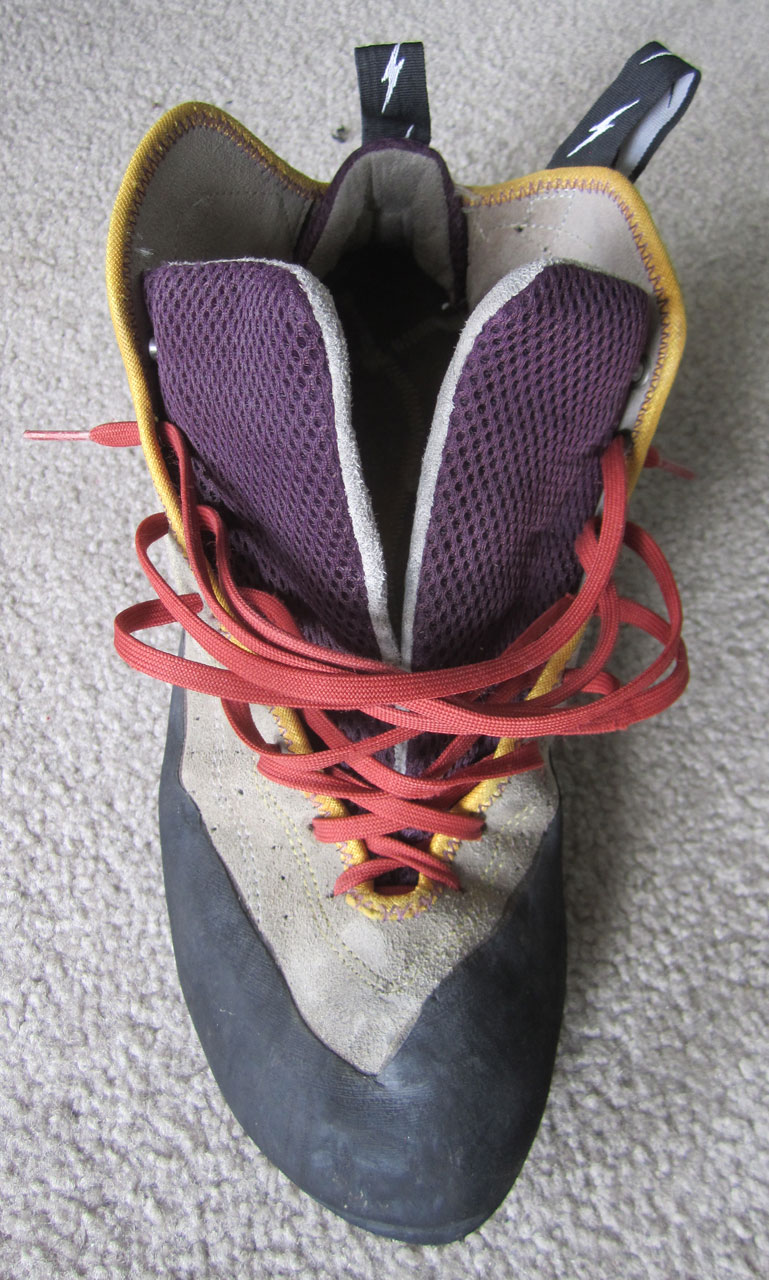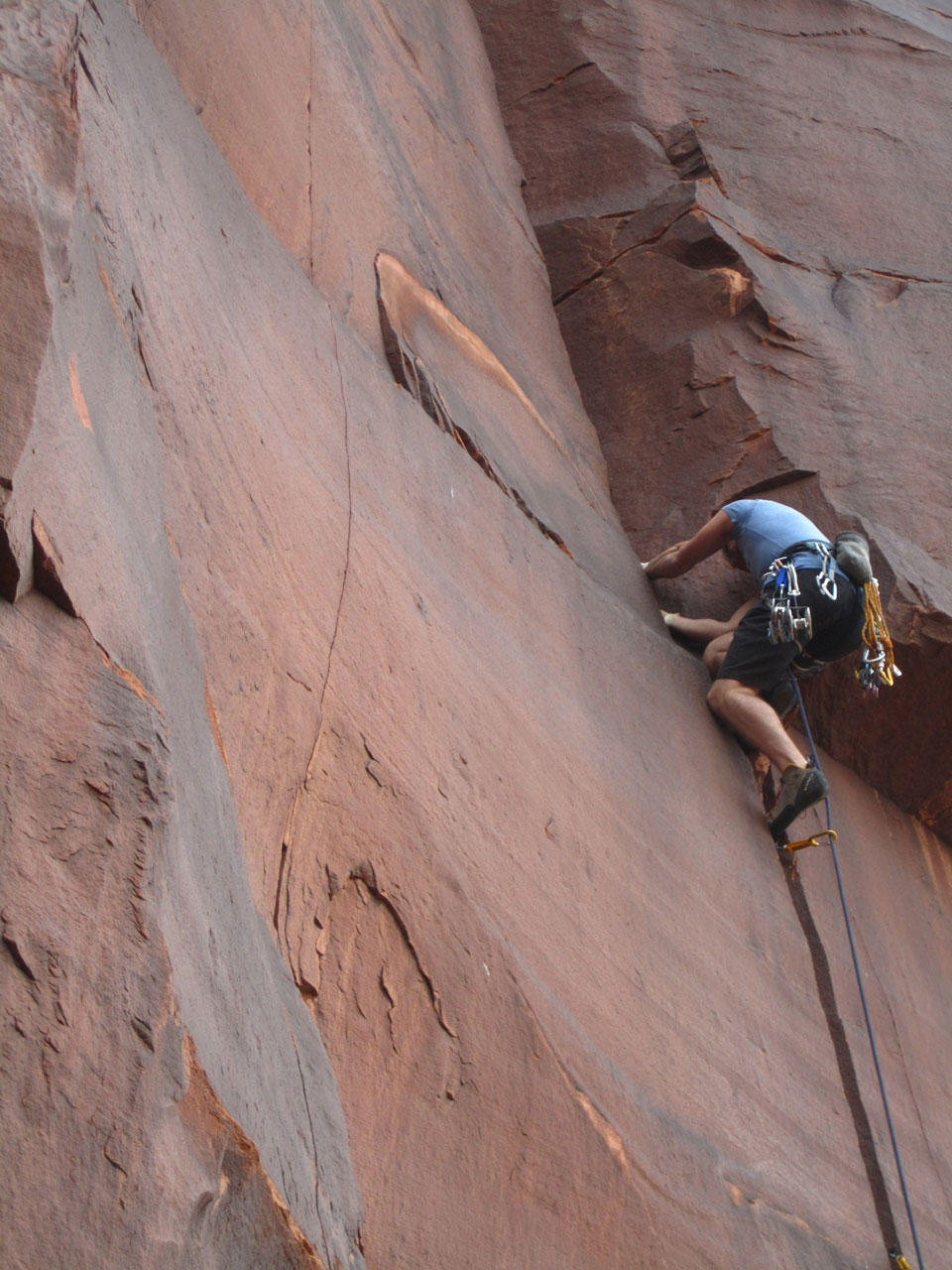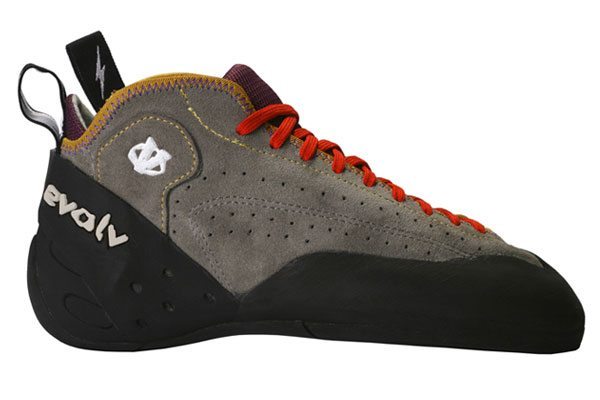Sizes: 4 – 13.5 (U.S. men’s, including half sizes)
Size Tested: 13
Profile: Slightly asymmetric
Sole: MX-P: 1mm half-length + 2mm full length
Rand: VTR rand (thicker front toe area)
Upper: Split leather
Lining: Microfiber forefoot, cotton heel
Midsole: MX-P: 1mm half-length + 2mm full length
My Foot: Size 13 street shoe, medium-volume (relative to its Sasquatch-like size, anyway), lower arch, neutral gait.
Days climbed: ~20
Locations: Indian Creek, Utah; Eldorado Canyon, Shelf Road, and Clear Creek Canyon, Colorado
MSRP: $145
The high-top climbing shoe, a once-ubiquitous style of shoe that had fallen out of fashion, is enjoying a renaissance in recent years with the success of shoes such as the La Sportiva TC Pro, the Five Ten Grandstone and Anasazi high-top, and now the Astroman by Evolv.
Evolv developed the Astroman in collaboration with Peter Croft, the legendary Yosemite climber of the 1980s who was—and is—well known for his first ascents of hard climbs all over the Sierras, and for his groundbreaking free-solos of some of the hardest lines of his day. Among the latter, his reputation as a top climber was cemented in 1987 by a one-day free solo link-up of Astroman and the Rostrum in Yosemite.
Having made a name for himself in this particular style of climbing, it shouldn’t be a surprise the shoes bearing Croft’s design are old-school-style high-tops best suited for crack climbing and long, all-day trad routes.
Fit / Sizing
When I first pulled the Astomans out of the box and tried them on at home, I was surprised by their size. As a trad shoe, I figured I’d be on the safe side of a comfortable, flat-toed fit by going with my street shoe size, but the Astromans were much tighter than I expected. While they didn’t fit like sport shoes, I definitely had some curl in my toes. I had barely had them on for 10 minutes, and I was already dreading wearing them in thin cracks.
My first days wearing them were spent mostly in a gym, with a smattering of outside days here and there, trying to break them in during the cold-weather months. Mercifully, I did get a generous half size of stretch out of them within a reasonably short amount of time—around seven days of use. After wearing them for a few months, I think I’ve worked most of the stretch out and they’re easier to wear for an extended period. My toes still aren’t flat, but I’m not in excrutiating pain, either. Given this moderate amount of stretch, I would probably go one half size larger, if only to accommodate the use of socks, were I to do it again.
For the sake of comparison, the original fit felt just a hair larger than a Five Ten Moccasym in a size 12, or a La Sportiva Miura in a size 46. I had expected a size 13 Astroman to feel dramatically larger than both of these shoes, but it seems the Astroman runs a bit small. I would recommend not going smaller than street shoe size, at least to start.
The already small sizes are made to feel even more snug by the narrow toe-box profile. From a performance perspective, this is a boon. The slimmer toe makes the Astroman much easier to maneuver in thin cracks than most of its contemporaries, with the exception of the La Sportiva TC Pro. From a sizing perspective, the slimmer toe box makes the shoe feel as though you could size it a half size larger and not be swimming in extra room up front.
Though they have a thin toe-box in common, the Astroman differs significantly from the TC Pro in width. While the European TC Pro is relatively slender, the Astroman fits my relatively wide feet comfortably.

Design
The Astroman also benefits from well-placed padding in the tongue and behind the heel, making the shoe more comfortable for me to wear. This is especially true when climbing hand cracks, where the padded tongue helps to minimize the abuse borne by the top of my foot.
The tongue itself is actually attached on the sides (rather than at its base, near the toes) and split down the middle. Given this design, it might be more apt to say the shoe has two “tongues” instead of one. Though a bit odd at first glance, it is effective as a method for keeping the padding centered over your foot, eliminating the problem of the tongue slowly sliding to one side or the other.
Sole
The defining characteristic of the Evolv Astroman is certainly the stiffness of the sole. Many recent trad climbing shoes, such as the TC Pro and Grandstone, are built on the same model. The idea, which sits it in direct opposition to some other crack shoes such as the Moccasym, is that a stiffer sole makes it more comfortable to jam cracks sized for hands or larger, while simultaneously improving the edging power of the shoe.
Both of these things are true and are readily apparent in the Astroman: it edges well, and is as comfortable as having your foot wedged in a crack gets.

The other side of this coin is that the stiffer sole makes it harder to smear and harder to work some of the rand / sole into a finger crack and twist it into place. The latter is certainly the case, and I occasionally found myself simply wedging some of the rand rubber into the edge of finger-sized cracks and relying on whatever friction I could find rather than generating a genuinely secure lock, as I might have with a softer shoe.
The former, on the other hand, is largely overcome by the quality of the rubber that makes up the sole. Yes, the shoe is stiff and insensitive as a result. You generally have to see your hold in order to place your foot onto it, which can certainly be a nuisance. But my fears of not being able to smear because of the stiff sole and instead having to drive an edge into every little ripple of rock proved to be largely unfounded. Because of the stiff sole, I had to work a little more to drape the most rubber possible onto a smear, but the rubber itself had some good bite and compensated for this fact.
Finally, at the risk of stating the obvious, the generally rigid nature of the shoe comes at the expense of sensitivity. It can at times be challenging to find footholds blindly, especially in cold weather. Stiffness and sensitivity are diametrically opposed qualities in a shoe, so this isn’t specific to the Astroman, but it is worth mentioning as it can be quite an adjustment for climbers coming from softer shoes like the Five Ten Moccasym or La Sportiva Mythos.


Hey Dave, great review! I’ve been hoping you’d review these!
Quick question: you mentioned the obvious competitor, the TC Pro, early in the review, but I am curious whether you can offer any additional insight into the difference in these two shoes? I primarily climb on granite, both cragging and alpine, in the PNW. Really dig cracks of all sizes, so I’m looking to add a high-top this season to compliment my lace-up Miuras. Obviously, fit is an issue, but I’m relatively certain both will fit. I haven’t tried them on back-to-back, but both felt comfortable individually. So really, it’s the differences in performance I’m curious about, and was hoping you maybe could talk to it a bit more…?
Thanks in advance, man.
Zak,
Great question, and I wish I could say more about that comparison. I’ve worn the TC Pros on a couple occasions for a total of a few pitches, but I’ve never owned a pair and really beaten them in. The shoe in general and the toe box in specific feel a bit slimmer on the TC Pro, but the width of the toe box tapers down pretty quickly on the Astroman, so it’s certainly possible that they both might fit decently depending on the shape of your foot.
I found the TC Pros to be a bit stiffer than the Astroman, especially around mid-sole. I know they have a well-deserved reputation as edging machines, and I think they probably beat out the Astroman in this area. I haven’t worn the TCs on slab, so I can’t comment other than to say the Astroman felt solid as can be hoped for on the slick, slabby holds that populate Eldorado. Comfort is probably a toss-up. The Astromans are a little more plush, with the padding, etc. but the shoes are similar enough in this regard that the real difference in comfort is going to come down to your foot as an individual.
Beyond those initial impressions, I’d venture to say that it’d be hard to go wrong either way. The Astroman doesn’t quite have the name recognition the TC Pro has, but it won’t hold you back in the alpine or at the crag, especially if you’re just looking to compliment a pair of lace-up Miuras, which you can wear for more technical footwork.
Out of curiosity, where in the PNW are you? Index by any chance?
Thanks for the quick response. I’ll prolly try to get them both on my feet back-to-back before I make any final purchasing decisions. I’m halfway starting to toy with wider cracks, so the full high top of the Astroman is appealing.
I rarely ask these types of “which shoe/ski/widget is best for me,” but I figured some context would be helpful to answer the question. Since you asked, I usually gape it up around Squamish, Leavenworth, Index, and alpine rock around the N. Cascades. (Toss me an email if there’s a pointed reason for this question.)
Hey Dave,
I really like your reviews, I think they are right on. It helps that my size shoe is also a 13 and so I selfishly benefit from that. Question for you, what shoe do you like for large feet like ours for thin cracks, specifically finger cracks up to thin hands? I have always struggled with this as its very hard for me to get my ‘large” foot in a secure finger jam. Thanks!
Jay,
Thanks for the encouragement! I really dig writing the reviews and I’m glad you’ve enjoyed reading them. Having a size 13 foot is for sure an obstacle, in my experience. The Astroman is definitely made in large enough sizes, 5.10 makes trad shoes for people like us, and Sportiva stops at size 46 but at least their scale runs a little bit larger than some others.
Before answering, I want to point out that there will have to be some expectation adjustment here: you’re never going to get your feet “in” a finger-lock sized crack. In the smaller sizes you’re going to be looking to smear the outside rand on the edges of the crack and get some stability that way, but it’s not totally analogous to a footwork in a hand crack. Having said that, working with a low toe profile is going to be a big help in the finger sizes, especially for people like me and you. I’d check out the La Sportiva Katana lace-up. The toe profile is lower than on the Astroman or TC Pro, it’s on the stiffer half of the spectrum but not so far as either of those hightops but somewhat more sensitive than the Astroman or TC Pro (though not nearly as sensitive as a 5.10 Mocc or Katana Velcro).
I’ve also spent a lot of time in the moccasym and like that for different reasons: it’s more sensitive and you’ll have an easier time wiggling rubber into a thin crack than you will with a stiffer shoe. I’m in the process of writing up a review of the katana lace as part of our push to move back to sumer content, so check back with us soon and let me know what you think!
Cheers,
Dave
How did the size you bought compare to the TC pro? Same size or larger? I use a 10.5 or 44 astroman so would a TC Pro in 44 make sense?
Mitch- I’ve generally found La Sportiva shoes to be slightly larger for a given size than most other brands out there, but Evolv’s shoes feel pretty true to size to me, so I’d guess that maybe the TC Pro would feel a little larger in the same size but not by much. I wear the Katana lace in a 46 (maybe snug 13 in US sizes) and while it’s a tighter fit than would be ideal, I can still wear them on multipitch routes without trouble.
I think the best thing would be to try them on if that is an option, however if that is out of the question I would recommend starting at a 44 for the TC Pro, though if you feel as though you are in between sizes with the Astroman in a 44, I would round down rather than up when moving to the TC Pro.
One last thought on this: the two shoes have pretty different lasts, so you’ll get a much different feel from one shoe to the next independent of how well the sizes fit. This can mean something like a different shape or volume toe box making a shoe feel larger or smaller than it’s true size, etc. so you may have to try more than one size to get it perfect.
Good luck! post up and let us know what you find out.
Cheers,
Dave